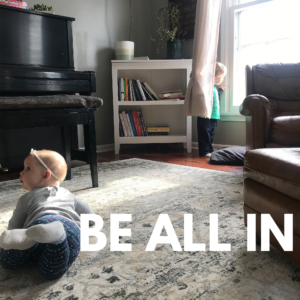Be ALL IN

This week my intention is to be all in, do one thing, then the next with gratitude.
You can learn more about what this intention setting practice is here.
I’ve been thinking for several days how to write about this intention, trying to parse together a single cohesive thought about how it so resonates within me right now. Some magical insight never came. I watched this brief clip from Beth Comstock’s interview with Elle Luna about being creative and realized I needed, in this instance, to set the bar lower and simply start.
The present is very temporary.
The present of that sentence is already over and has become the past. It is that fleeting.
For some reason, I had always associated being ALL IN as something that started but never finished. It’s like a Project Management Gantt Chart that extends endlessly in the future once it’s declared. Each decision point was like adding another line item in the project plan that would carry over through Week 14 and into week 144 so being fully committed and being all in on anything was a much harder decision.
And that was flawed thinking because the act of being ALL IN is completely and entirely NOW aka present moment driven.
Being all in on this present moment is not a contract binding you in perpetuity.
Being all in is a commitment to presence.
How does being ALL IN look?
- It means to eliminate distractions because what’s in front of me is of paramount importance.
- Professionally, it means: Turning my wifi off while I write this because the ding of an email will set me off course.)
- Personally, it means: Putting my phone away.
- It means that at this moment I’m not looking at the “other” as a means of distraction by comparison.
- Professionally, it means: I’m not seeing a newly released course wistfully thinking “that could have been me!”.
- Personally, it means: Someone was video-ready on Instagram when I am very much not.
- It means that I’m not future-tripping or past-leaning.
- Professionally, it means: I’m not thinking about the retreat in Phoenix I want to host and I’m not beating myself up for commas.
- Personally, it means: I’m not day-dreaming about bedtime while making sandwiches for lunch and I’m not beating myself up for calling cupcakes breakfast.
- It means I’m looking at the best next step and not step 111.
- Professionally, it means: I’m sending the proposal and not thinking about how this will be impacting my hypothetical month in Santa Barbara next February.
- Personally, it means: I’m going out for the walk not looking for a carriage house that can accommodate the full gym I’d like to have 20 steps from my home.
When you’re not “all in” life can seem a little easier because you can live in the illusion if you had been “all in” it would have turned out so much better.
But that’s not an illusion I want to live within.
I want to be all in. I want to live all in. I want to do work that I’m all in on and if I’m not I’m going to stop doing that work.
Being all in is the kryptonite to “I’ll be happy when….”.
How would your week look if you were ALL IN?
What would you learn in that week? I say we find out. I’m going to formalize this experiment with a daily spreadsheet inspired by Jim Collins and I’d urge you to join me in the tracking. Here’s how I’m approaching it:
Column A: Task
Column B: +2 , +1, 0, -1. -2
Column C: Noted Failure of ALL IN
As I am doing a task in single-task ALL IN fashion I’m going to track it and then associate how it FELT to do that thing. -2 is so painful I’d rather not ever do that task again to +2 being a complete delight, I’m also going to track if I’ve failed at being ALL IN for example if I simply could not send that client email without first checking LinkedIn, Facebook and the specials at the local pub.
On Friday I’m going to walk through my own analysis of this and lessons learned. Want to be a part of that? You can join my Zoom for the live walk-through here.

